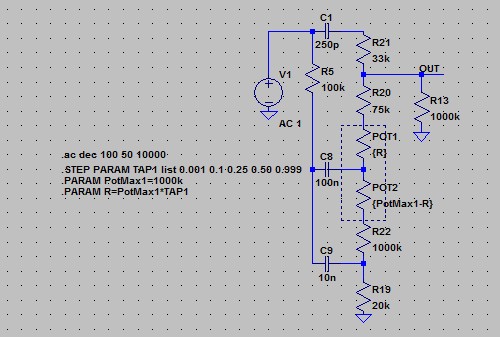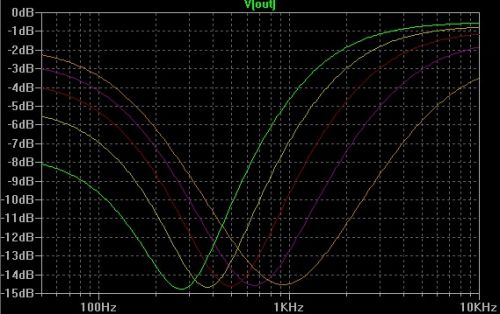Make your fixed tone stack sweepable
By vinic on March 19 - 2015, 22:21 - Permalink
Here is a tip to add huge sound flexibility to a fixed tone stack, using a single potentiometer and changing few components value.
This applies to my Fame Tube 5 amp, but also all the similar amps (Harley Benton GA5, Gibson GA-5, Fender Champion 600, Gretsch G5222, etc).

From original Tube 5 schematic, the modified components are :
- C1 : 680pF to 250pF
- C9 : 47nF to 10nF
- optionally R22 : 75k to 1000k (1M)
The potentiometer is drawn as 2 resistors POT1 and POT2, inserted between R20 and R22, and with cursor going to C8. This is a 1M logarithmic potentiometer.
What it does :

As you turn the potentiometer, it will sweep both the bass and treble filters of the tone stack. C1 and C9 have to be selected in order to make those filters cut frequencies moving at same "speed". Otherwise, you would get a deeper "mid hole" at higher frequencies (or lower, depending on capacitors choosen). 250pF+10nF is a good couple. 390pF+15nF works well too, it will shift the tuning range a bit lower to 175-615Hz. 120pF+4.7nF will shift the tuning range to 565-2000Hz. As you see, with common capacitors values, the best option is 250pF+10nF which allows to keep the range around the initial value of the fixed tone stack.
Optionally, and you may want to do it, you can raise R22 to 1000k, allowing to keep some bass on the lowest setting (green curve). Otherwise, the frequency response stays flat at -15dB below the "mid hole".
I have to mention that the logarithmic potentiometer acts like a "TONE" knob, it makes the tone darker CCW and brighter CW, i.e. the higher setting, the lower "mid hole" frequency. You may prefer to use an anti-log potentiometer to reverse the action
Hope this helps!